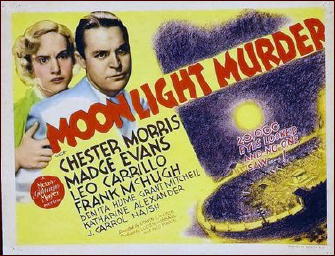Sat 5 Jul 2014
A Movie Review by David Vineyard: MOONLIGHT MURDER (1936).
Posted by Steve under Mystery movies , Reviews[4] Comments
MOONLIGHT MURDER. MGM, 1936. Chester Morris, Madge Evans, Leo Carrillo, Frank McHugh, J. Carroll Naish, H.B. Warner, Grant Mitchell, Duncan Renaldo, Robert McWade. Directed by Edward L. Marin.
A well done little programmer with Chester Morris as detective Steve Farrell a homicide cop who finds himself up to his neck in murder with an opera troupe playing at the Hollywood Bowl. This solid little murder mystery has an actual plot, clever murder method, an armful of suspects who have motive, and a nice twist you will only see coming because of the actor cast in the role.
Leo Carrillo is Gino, opera star extraordinary, egotistical, vain, and ladies’ man playing the women in the cast off each other. His stand-in (Ivan Bosoff) wants to replace him on stage, conductor H. B. Warner is fed up with the whole cast, the young male ingenue (Duncan Renaldo) loves one of the women Gino is seducing, both young women (Benita Hume, Elizabeth Anderson) being played by Gino have motive, as does even his valet (Frank McHugh), as the only one who benefits from Gino’s will. Then there is mad composer J. Carroll Naish who is obsessed by Gino and overhears a threat to his life.
Police Chief Quinlin (Robert McWade) doesn’t think there is anything to it, but young detective Steve Farrell does, and between Gino’s bouts with illness and the insane Naish, there is enough to keep him around, not to mention his attraction to Gino’s physician friend Dr. Adams (Grant Mitchell)’s niece Toni (Madge Evans), a scientist who clicks with him as you can only click in the movies. Then Naish escapes from Steve on the opening night of the opera and Gino collapses on stage, dead, in mid performance.
Gino was murdered, but the poison was delivered airborne and he was on stage alone in front of thousands of witnesses including his doctor and the Chief.
There is some neat detective work going on, and this relies much less on dumb luck than most film murder mysteries. All the suspects have legitimate motives, and each one is suspected in turn. There are red herrings, misdirection, dead-end clues, and when a second murder occurs under Steve’s nose he ends up back on the beat for concealing embarrassing letters written by the opera’s diva.
Dr. Adams thinks he might find something at the site of the murder, but he is attacked too. He’s only shaken up, but Steve, on patrol at the murder scene, discovers the clue that will break the case, only to find himself confronted by two suspects, neither of whom he wants to believe could have murdered Gino.
I won’t give away the murderer or the method. because both are better than you might expect, and for once the least likely suspect is both logical and has a legitimate motive that the movie has actually played fair with. If you were paying attention you could actually watch this and solve the case: for once nothing is concealed and and you have as much chance of solving the case as Morris’s Steve Farrell does.
Like Edmond Lowe, Morris was born to play detectives. His rapid patter, razor profile, and direct acting style made him ideal for this sort of thing. You always felt there was a mind working behind Morris’s actions in this sort of film and that his brains weren’t all in his fists.
The cast is solid, though Naish chews the scenery to the point you may want to commit murder yourself. He’s generally a fine actor, but some of the grimaces on his face may have you laughing too hard to actually pay attention to what’s happening on screen. He plays his madman so crazy you have to wonder he wasn’t already locked away for life before the film began. It’s about the only misstep in the film though.
All in all, this little sleeper turns out to be a pleasant surprise, and a decent murder mystery you might well admire in a book, much less a film.


July 5th, 2014 at 8:00 pm
Saw this years ago, and it’s one case where the MGM gloss really enhances what would have been a forgettable “B”. Of added interest was seeing Duncan Renaldo & Leo Carillo together years before THE CISCO KID!
July 5th, 2014 at 8:05 pm
Hmm, I typed in the credits, Dan, and I didn’t see that!
July 5th, 2014 at 8:07 pm
PS. I thought I’d DVRed this movie from TCM last week, but if so, it seems to have disappeared on me. I may decide to spring for the Warner Archives release, which I hadn’t noticed before. I see that oldies.com is having a sale…
July 7th, 2014 at 2:34 pm
This is much better and slicker than it has any right to be, and the script seems to be by someone who can actually plot a mystery. It helps to that the acting is much better than the average B.
Ironic that Carrillo and Renaldo are romantic rivals here; “Oh, Pancho,”—-“Oh, Cisco!” indeed. This must have been just before Renaldo’s career crippling battle with Immigration that was finally brought to an end by FDR himself.
I met Renaldo in the late sixties, and save for a few pounds he was still recognizable. A man every bit as charming and natural as his screen persona, and quite happy to discuss the Cisco Kid considering the millions it made for him. One of the rare Hollywood examples of a nice guy not finishing last.